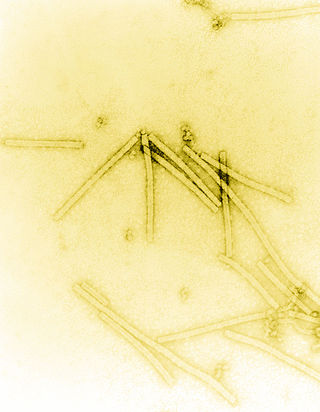
Tobacco mosaic virus (TMV) is a positive-sense single-stranded RNA virus species in the genus Tobamovirus that infects a wide range of plants, especially tobacco and other members of the family Solanaceae. The infection causes characteristic patterns, such as "mosaic"-like mottling and discoloration on the leaves. TMV was the first virus to be discovered. Although it was known from the late 19th century that a non-bacterial infectious disease was damaging tobacco crops, it was not until 1930 that the infectious agent was determined to be a virus. It is the first pathogen identified as a virus. The virus was crystallised by Wendell Meredith Stanley. It has a similar size to the largest synthetic molecule, known as PG5.
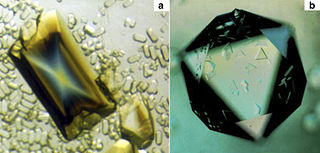
A satellite is a subviral agent that depends on the coinfection of a host cell with a helper virus for its replication. Satellites can be divided into two major classes: satellite viruses and satellite nucleic acids. Satellite viruses, which are most commonly associated with plants, are also found in mammals, arthropods, and bacteria. They encode structural proteins to enclose their genetic material, which are therefore distinct from the structural proteins of their helper viruses. Satellite nucleic acids, in contrast, do not encode their own structural proteins, but instead are encapsulated by proteins encoded by their helper viruses. The genomes of satellites range upward from 359 nucleotides in length for satellite tobacco ringspot virus RNA (STobRV).

Tobamovirus is a genus of positive-strand RNA viruses in the family Virgaviridae. Many plants, including tobacco, potato, tomato, and squash, serve as natural hosts. Diseases associated with this genus include: necrotic lesions on leaves. The name Tobamovirus comes from the host and symptoms of the first virus discovered.

Potyvirus is a genus of positive-strand RNA viruses in the family Potyviridae. Plants serve as natural hosts. Like begomoviruses, members of this genus may cause significant losses in agricultural, pastoral, horticultural, and ornamental crops. More than 200 species of aphids spread potyviruses, and most are from the subfamily Aphidinae. The genus contains 190 species and potyviruses account for about thirty percent of all currently known plant viruses.

Begomovirus is a genus of viruses, in the family Geminiviridae. They are plant viruses that as a group have a very wide host range, infecting dicotyledonous plants. Worldwide they are responsible for a considerable amount of economic damage to many important crops such as tomatoes, beans, squash, cassava and cotton. There are 445 species in this genus.
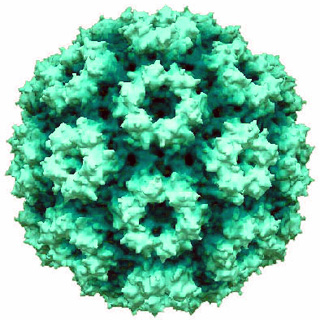
Cowpea chlorotic mottle virus, known by the abbreviation CCMV, is a virus that specifically infects the cowpea plant, or black-eyed pea. The leaves of infected plants develop yellow spots, hence the name "chlorotic". Similar to its "brother" virus, Cowpea mosaic virus (CPMV), CCMV is produced in high yield in plants. In the natural host, viral particles can be produced at 1–2 mg per gram of infected leaf tissue. Belonging to the bromovirus genus, cowpea chlorotic mottle virus (CCMV) is a small spherical plant virus. Other members of this genus include the brome mosaic virus (BMV) and the broad bean mottle virus (BBMV).
Asparagus virus 1 (AV-1) is one of the nine known viruses that infects asparagus plants. It is a member of the genus Potyvirus in the family Potyviridae. Initially reported by G. L Hein in 1960, it causes no distinct symptoms in asparagus plants. The only known natural plant host is the asparagus. It is spread by aphid vectors, which means that aphids do not cause the AV-1, but they do spread it.

Apple mosaic virus (ApMV) is a plant pathogenic virus of the family Bromoviridae. It is named after its symptoms that were first present on apples. ApMV is a positive sense RNA based virus. The disease itself has several synonyms including Mild Apple Mosaic Virus, Hop Virus, Rose Mosaic Virus, and European Plum Line Patten Virus. It causes a severe yield reduction and decreased life-expectancy of fruit trees.
Cherry mottle leaf virus (CMLV) is a plant pathogenic virus causing leaf rot. It is closely related to the peach mosaic virus.
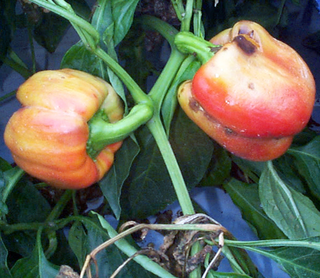
Pepper mild mottle virus (PMMoV) is a plant pathogenic virus that occurs worldwide on species of field grown bell, hot and ornamental pepper species. It is caused by members of the plant virus genus Tobamovirus- otherwise known as the tobacco mosaic virus family. Tobamovirus are viruses that contain positive sense RNA genomes that infect plants. Symptoms of the disease vary depending on the cultivar. Typical symptoms include the chlorosis of leaves, stunting, and distorted and lumpy fruiting structures. The virus is spread by mechanical transmission and infected seeds. Avoidance is the best means of controlling the disease because once a plant is infected it cannot be treated. Only seeds that have been tested and treated for the pathogen should be planted.
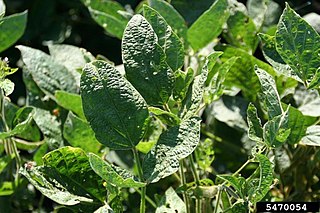
Soybean mosaic virus (SMV) is a member of the plant virus genus Potyvirus. It infects mainly plants belonging to the family Fabaceae but has also been found infecting other economically important crops. SMV is the cause of soybean mosaic disease that occurs in all the soybean production areas of the world. Soybean is one of the most important sources of edible oil and proteins and pathogenic infections are responsible for annual yield losses of about $4 billion in the United States. Among these pathogens, SMV is the most important and prevalent viral pathogen in soybean production worldwide. It causes yield reductions of about 8% to 35%, but losses as high as 94% have been reported.

Benyvirus is a genus of viruses, in the family Benyviridae. Plants serve as natural hosts. There are four species in this genus. Diseases associated with this genus include: BNYVV: rhizomania.

Orthotospovirus is a genus of negative-strand RNA viruses, in the family Tospoviridae of the order Bunyavirales, which infects plants. Tospoviruses take their name from the species Tomato spotted wilt orthotospovirus (TSWV) which was discovered in Australia in 1919. TSWV remained the only known member of the family until the early 1990s when genetic characterisation of plant viruses became more common. There are now at least twenty species in the genus with more being discovered on a regular basis. Member viruses infect over eight hundred plant species from 82 different families.

Carlavirus, formerly known as the "Carnation latent virus group", is a genus of viruses in the order Tymovirales, in the family Betaflexiviridae. Plants serve as natural hosts. There are 53 species in this genus. Diseases associated with this genus include: mosaic and ringspot symptoms.
High plains disease is a viral disease afflicting wheat and maize. It is caused by the negative-sense ssRNA virus High Plains wheat mosaic emaravirus. Symptoms are similar to Wheat streak mosaic virus, with leaf veins showing yellow flecks and streaks, followed by leaf margin purpling in maize. Depending on the timing of infection, stunting and death occur. Plants can be doubly infected with high plains virus and wheat streak mosaic virus.
Chilli leaf curl virus(ChiLCV) is a DNA virus from the genus Begomovirus and the family Geminiviridae. ChiLCV causes severe disease especially in pepper (Capsicum spp.), but also affects other crops such as tomato (Solanum lycopersicum). It can be found in tropical and subtropical regions primarily in India, but has also been detected in countries such as Indonesia and Sri Lanka. This virus is transmitted by an insect vector from the family Aleyrodidae and order Hemiptera, the whitefly Bemisia tabaci. The primary host for ChiLCV are several Capsicum spp., but host species also include tomato and amaranth. ChiLCV has been responsible for several epidemics and causes severe economic losses. It is the focus of research trying to understand the genetic basis of resistance. Currently, a few sources of resistance have been discovered and used to breed resistant varieties.

Said Amin (Gabe) Ghabrial was an Egyptian-American plant pathologist, known for his work on mycoviruses – viruses of fungi – and particularly their effects on the virulence of plant-pathogenic fungi. He also researched bean pod mottle virus, an economically important soybean disease. He was professor of plant pathology at the University of Kentucky (1986–2014).
Clerodendrum golden mosaic China virus (ClGMCNV) is a bipartite Begomovirus isolated from flowering plants in the Clerodendrum genus. The virus causes yellow mosaic disease in various plant species, including Nicotiana, Petunia, Solanum, and Capsicum species. It is associated with a mosaic disease known as 'Dancing Flame'.

Tomato brown rugose fruit virus (ToBRFV) is a plant virus in the genus Tobamovirus that was first described in 2015. It has spread rapidly since it was first noted in Jordan and Israel. The main hosts are tomato and peppers. The virus causes symptoms including mosaic and distortion of leaves and brown, wrinkly spots (rugose) on fruits. Outbreaks can be severe and leave fruit unmarketable.













